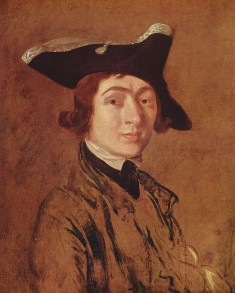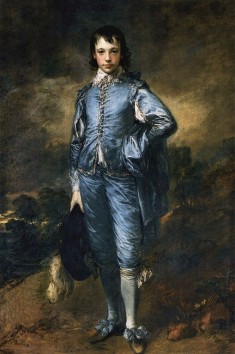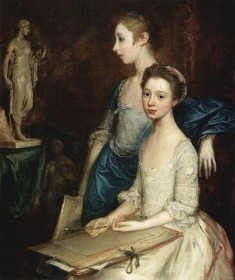| Thomas Gainsborough | |
|---|---|
 |
|
| Born |
May 14, 1727 (christened) Sudbury, Suffolk, England |
| Died | Aug. 2 1788 (at age 61) London, England |
| Nationality | British |
| Movement | Romanticism |
| Field | Painting |
| Works | |
Thomas Gainsborough (1727-1788) was among the most renowned of all English painters. He is particularly noted for his landscapes and portraits, although he is known to have preferred painting landscapes. He was the co-founder of the 18th century school of British landscapes, along with Richard Wilson. Although Gainsborough was one of the Royal Academy’s founding members, he often argued with it.
Early Life and Influences
Gainsborough was born in the Suffolk town of Sudbury, and he was the youngest child in his family. His father, who carried on a trade as a weaver, was impressed by the young Thomas’s ability to draw when he was 13. As a result, the child was permitted to leave home in 1740 in order to begin his studies in art in London. While in London, Gainsborough was initially a pupil of Hubert Gravelot, an engraver. However, he soon formed an association with the school of the artist William Hogarth.
Among Gainsborough’s earliest notable works were his contributions to the building which today houses the Thomas Coram Foundation. He was also engaged by Francis Hayman in decorating the Vauxhall Gardens supper boxes. In 1746, he married the Duke of Beaufort’s illegitimate daughter, Margaret Burr. At this time, Gainsborough was mostly painting landscapes, but they were not proving popular with buyers. Two years later, he went back to his home town and turned to portraits.
Road to the Royal Academy
 By 1752, Gainsborough’s family had grown with the birth of his two daughters. Moving to Ipswich produced a rise in demand for his portraits, but his clientele was largely restricted to squires and merchants from the local area. Seven years later, he moved to Bath, where he had more success.
By 1752, Gainsborough’s family had grown with the birth of his two daughters. Moving to Ipswich produced a rise in demand for his portraits, but his clientele was largely restricted to squires and merchants from the local area. Seven years later, he moved to Bath, where he had more success.
By 1761, he was sending paintings to the London exhibitions of the Society of Arts, and these increased his national reputation. This brought Gainsborough an invitation to be a founding member of the Royal Academy in 1769. A year later, he painted The Blue Boy, a portrait in oils of a youth that ranks among his most famous works.
Frequent disputes with the Royal Academy led to exhibiting his paintings there in 1773. Gainsborough took his family to Pall Mall, London, in 1774. Today, the house bears a blue plaque to commemorate its association. Three years later, the artist decided to resume the exhibition of his works at the Royal Academy. At that time, they included a number of portraits of notable personalities of the time, including the Duke of Cumberland and his wife. Gainsborough continued to exhibit his paintings there for six years.
Royal Patronage
After Gainsborough painted King George III and Queen Charlotte in 1780, Gainsborough became the recipient of a number of commissions to paint royalty. This allowed him to exert his influence over the Royal Academy to a greater degree, in particular in the way he wanted his works to be shown. Nevertheless, in 1783, he took the decision to withdraw his paintings from that year’s exhibition and instead showcased them at Schomberg House.
Gainsborough’s Later Years
 The following year saw the death of Allan Ramsay, the incumbent royal painter, but the king passed over Gainsborough and instead gave the job to Joshua Reynolds, the president of the Royal Academy and a rival of Gainsborough’s. Nevertheless, Gainsborough retained great popularity with the royal family.
The following year saw the death of Allan Ramsay, the incumbent royal painter, but the king passed over Gainsborough and instead gave the job to Joshua Reynolds, the president of the Royal Academy and a rival of Gainsborough’s. Nevertheless, Gainsborough retained great popularity with the royal family.
Upon his death from cancer in 1788, he was buried at the same church in Kew where many royals worshipped. Late in life, the artist turned to simple landscapes which emphasized plain, light brush strokes.
Gainsborough’s Technical Assessment
Among Gainsborough’s most notable features was the rapidity with which he painted even large pieces of work. He tended to ignore the rules laid down by academia and instead worked from life and his own observations.
His contemporary, the English artist John Constable, found himself impressed by the results, saying that Gainsborough’s paintings brought tears to his eyes, although he was unable to say exactly which component of Gainsborough’s style was responsible for this effect.
The artist himself became increasingly unhappy with life as a portraitist as his life progressed. He even went so far as to say he was “sick of portraits” and that his dream was to retire to a small, quiet village and paint only landscapes.
Gainsborough’s later works show a particularly light palette, as well as brush strokes which have an economical and easy feel to them. Even when painting portraits, such as 1785’s Cottage Girl with Dog and Pitcher, he tended to show figures in such a way as to draw the eye back from the portrait itself to the surrounding landscape.